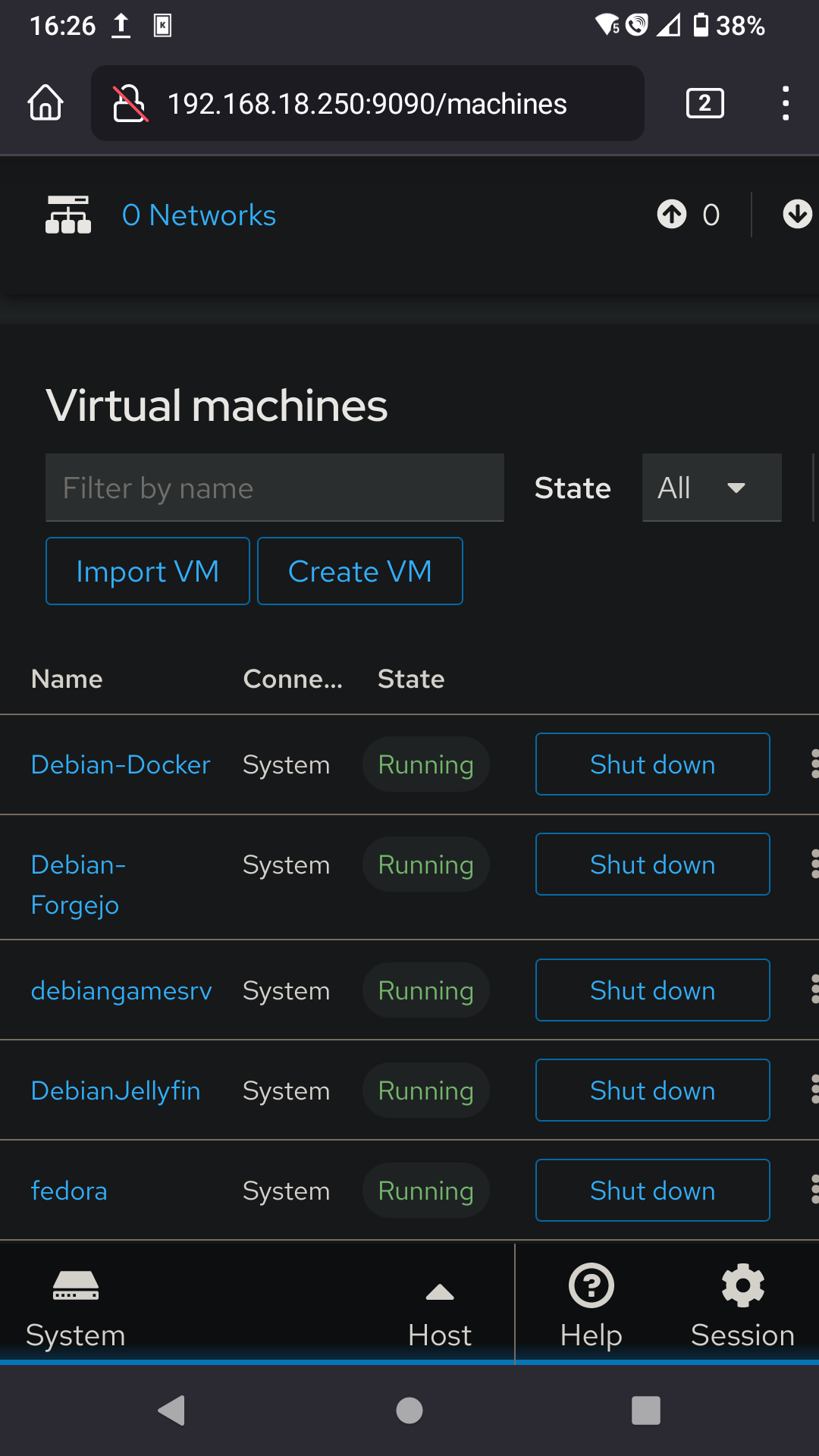With free esxi over, not shocking bit sad, I am now about to move away from a virtualisation platform i’ve used for a quarter of a century.
Never having really tried the alternatives, is there anything that looks and feels like esxi out there?
I don’t have anything exceptional I host, I don’t need production quality for myself but in all seriousness what we run at home end up at work at some point so there’s that aspect too.
Thanks for your input!


/thread
This is my go-to setup.
I try to stick with libvirt/
virshwhen I don’t need any graphical interface (integrates beautifully with ansible [1]), or when I don’t need clustering/HA (libvirt does support “clustering” at least in some capability, you can live migrate VMs between hosts, manage remote hypervisors from virsh/virt-manager, etc). On development/lab desktops I bolt virt-manager on top so I have the exact same setup as my production setup, with a nice added GUI. I heard that cockpit could be used as a web interface but have never tried it.Proxmox on more complex setups (I try to manage it using ansible/the API as much as possible, but the web UI is a nice touch for one-shot operations).
Re incus: I don’t know for sure yet. I have an old LXD setup at work that I’d like to migrate to something else, but I figured that since both libvirt and proxmox support management of LXC containers, I might as well consolidate and use one of these instead.
I use cockpit and my phone to start my virtual fedora, which has pcie passthrough on gpu and a usb controller.
Desktop:

Mobile:

We use cockpit at work. It’s OK, but it definitely feels limited compared to Proxmox or Xen Orchestra.
Red Hat’s focus is really on Openstack, but that’s more of a cloud virtualization platform, so not all that well suited for home use. It’s a shame because I really like Cockpit as a platform. It just needs a little love in terms of things like the graphical console and editing virtual machine resources.
Ooh, didn’t know libvirt supported clusters and live migrations…
I’ve just setup Proxmox, but as it’s Debian based and I run Arch everywhere else, then maybe I could try that… thanks!
In my experience and for my mostly basic needs, major differences between libvirt and proxmox:
virt-cloneandvirt-sysprep.virt-installand a Debian preseed.cfg to provision new templates, on proxmox I do it… well… manually. But both support cloud-init based provisioning so I might standardize to that in the future (and ditch templates)My understanding is that for proper cluster management you slap Pacemaker on there.
LXD/Incus provides a management and automation layer that really makes things work smoothly essentially replacing Proxmox. With Incus you can create clusters, download, manage and create OS images, run backups and restores, bootstrap things with cloud-init, move containers and VMs between servers (even live sometimes) and those are just a few things you can do with it and not with pure KVM/libvirt. Also has a WebUI for those interested.
A big advantage of LXD is the fact that it provides a unified experience to deal with both containers and VMs, no need to learn two different tools / APIs as the same commands and options will be used to manage both. Even profiles defining storage, network resources and other policies can be shared and applied across both containers and VMs.
Incus isn’t about replacing existing virtualization techniques such as QEMU, KVM and libvirt, it is about augmenting them so they become easier to manage at scale and overall more efficient. It plays on the land of, let’s say, Proxmox and I can guarantee you that most people running it today will eventually move to Incus and never look back. It woks way better, true open-source, no bugs, no holding back critical fixes for paying users and way less overhead.
You can perform a live migration without shared storage with libvirt
I should RTFM again… https://manpages.debian.org/bookworm/libvirt-clients/virsh.1.en.html has options for
virsh migratesuch as--copy-storage-all… Not sure how it would work for actual live migrations but I will definitely check it out. Thanks for the hintPretty darn well. I actually needed to do some maintenance on the server earlier today so I just migrated all of the VMs over to my desktop, did the server maintenance, and then moved the VMs back over to the server, all while live and functioning. Running ping in the background looks like it missed a handful of pings as the switches figured their life out and then was right back where they were; not even long enough for uptime-kuma to notice.
I didn’t know libvirt supported HA
Did you read? I specifically said it didn’t, at least not out-of-the-box.
clustering != HA
The “clustering” in libvirt is limited to remote controlling multiple nodes, and migrating hosts between them. To get the High Availability part you need to set it up through other means, e.g. pacemaker and a bunch of scripts.
Maybe you should consider consolidating into Incus. You’re already running on LXC containers why keep using and dragging all the Proxmox bloat and potential issues when you can use LXD/Incus made by the same people who made LXC that is WAY faster, stable, more integrated and free?
Hey look, it’s the Incus guy. Every time this topic comes up, you chime in and roast Proxmox and it potential issues with a link go a previous comment roasting Proxmox and it’s potential issues and at no point go into what those potential issues are outside of the broad catch all term of ‘bloat’.
I respect your data center experience, but I wish you were more forward with your issues instead of broad, generalized terms.
As someone with much less enterprise experience, but small business it administration experience, how does Incus replace ESXi for virtual machines coming from the understanding that “containerization is the new hotness but doesn’t work for me” angle?
deleted by creator
deleted by creator
You funny guy 😂😂
Now, I’m on my phone so I can’t write that much but I’ll say that the post I liked to isn’t about potential issue, it goes over specific situations where it failed, ZFS, OVPN, etc. but I won’t obviously provide anyone with crash logs and kernel panics.
About ESXi: Incus provides you with a CLI and Web interface to create, manage, migrate VMs. It also provides basic clustering features. It isn’t as feature complete as ESXi but it gets the job done for most people who just want a couple of VMs. At the end of the day it is more inline with what Proxmox than what ESXi offers BUT it’s effectively free so it won’t hold important updates from users running on free licenses.
If you list what you really need in terms of features I can point you into documentation or give my opinion how how they compare and what to expect.
The migration is bound to happen in the next few months, and I can’t recommend moving to incus yet since it’s not in stable/LTS repositories for Debian/Ubuntu, and I really don’t want to encourage adding third-party repositories to the mix - they are already widespread in the setup I inherited (new gig), and part of a major clusterfuck that is upgrade management (or the lack of). I really want to standardize on official distro repositories. On the other hand the current LXD packages are provided by snap (…) so that would still be an improvement, I guess.
Management is already sold to the idea of Proxmox (not by me), so I think I’ll take the path of least resistance. I’ve had mostly good experiences with it in the past, even if I found their custom kernels a bit strange to start with… do you have any links/info about the way in which Proxmox kernels/packages differ from Debian stable? I’d still like to put a word of caution about that.
DO NOT migrate / upgrade anything to the snap package that package is from Canonical and it’s after the Incus fork, this means if you do for it you may never be able to then migrate to Incus and/or you’ll become hostage of Canonical.
About the rest, if you don’t want to add repositories you should migrate into LXD LTS from Debian 12 repositories. That version is and will be compatible with Incus and both the Incus and Debian teams have said that multiple times and are working on a migration path. For instance the LXD from Debian will still be able to access the Incus image server while the Canonical one won’t.
It was already in place when I came in (made me roll my eyes), and it’s a mess. As you said, there’s no proper upgrade path to anything else. So anyway…
The LXD version in Debian 12 is buggy as fuck, this patch has not even been backported https://github.com/canonical/lxd/issues/11902 and 5.0.2-5 is still affected. It was a dealbreaker in my previous tests, and doesn’t inspire confidence in the bug testing and patching process on this particular package. On top of it, It will be hard to convice other guys that we should ditch Ubuntu and their shenanigans, and that we should migrate to good old Debian (especially if the lxd package is in such a state). Some parts of the job are cool, but I’m starting to see there’s strong resistance to change, so as I said, path of least resistance.
Do you have any links/info about the way in which Proxmox kernels/packages differ from Debian stable?
So you say it is “buggy as fuck” because there’s a bug that makes it so you can’t easily run it if your locate is different than English? 😂 Anyways you can create the bride yourself and get around that.
About the link, Proxmox kernel is based on Ubuntu, not Debian…
It sends pretty bad signals when it causes a crash on the first
lxd init(sure I could make the case that there are workarounds, switch locales, create the bridge, but it doesn’t help make it appear as a better solution than proxmox). Whatever you call it, it’s a bad looking bug, and the fact that it was not patched in debian stable or backports makes me think there might be further hacks needed down the road for other stupid bugs like this one, so for now, hard pass on the Debian package (might file a bug on the bts later).Thanks for the link mate, Proxmox kernels are based on Ubuntu’s, which are in turn based on Debian’s, not arguing about that - but I was specifically referring to this comment
any example/link to bug reports for such fixes not being applied to proxmox kernels? Asking so I can raise an orange flag before it gets adopted without due consideration.
Well what I can say is that since my team migrated everything to LXD/Incus the amount of tickets that are somehow related to the virtualization solution we used dropped really fast. Side note: we started messing around with LXD from Snap (but running under Debian) and moved to Debian 12 version as soon as it was made available.
About the kernel things, my upstream fix comment was about how Canonical / Ubuntu does things. They usually come up with some “clever” ideia to hack something, implement it and then the upstream actually solves the issue after proper evaluation and Ubuntu just takes it and replaces their quick hack. This happens quite frequently and it’s not always a few lines of code, for instance, it happened with the mess that shiftfs was and then the kernel guys come up with a real solution (idmapped) and now you see Canonical is going for it. Proxmox inherits the typical Canonical mess.